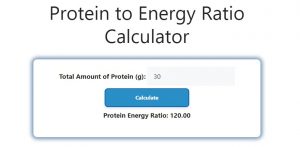About Protein to Energy Ratio Calculator (Formula)
Understanding the relationship between protein intake and energy production is vital for anyone focused on nutrition, fitness, or weight management. The Protein to Energy Ratio Calculator helps individuals determine the energy derived from protein in their diet, allowing for informed dietary choices. This article will delve into the formula used for calculating the protein energy ratio, explain how to use the calculator, provide a practical example, and answer common questions regarding the topic.
Formula
The formula for calculating the Protein Energy Ratio (E) is:
Protein Energy Ratio (E) = Protein Amount (g) * 4
This formula indicates that each gram of protein provides approximately 4 kilocalories of energy.
How to Use
Using the Protein to Energy Ratio Calculator is simple. Follow these steps:
- Determine Protein Amount: Measure the amount of protein in grams from the food item or meal you wish to analyze.
- Input the Value: Enter the protein amount into the calculator.
- Calculate Energy: The calculator will multiply the protein amount by 4 to determine the total energy contribution from protein.
- Analyze Results: Review the output to understand how much energy your protein intake provides in the context of your overall diet.
Example
Let’s say you consume a meal that contains 30 grams of protein. To calculate the protein energy ratio:
Protein Energy Ratio (E) = Protein Amount (g) * 4
Protein Energy Ratio (E) = 30 g * 4
Protein Energy Ratio (E) = 120 kilocalories
In this example, the protein in the meal contributes 120 kilocalories of energy.

FAQs
- What is the Protein to Energy Ratio?
The Protein to Energy Ratio indicates how much energy is derived from the protein in your diet. - Why is the Protein to Energy Ratio important?
It helps assess whether your protein intake aligns with your energy needs, supporting better dietary choices. - How is the energy from protein calculated?
The energy from protein is calculated by multiplying the protein amount in grams by 4. - What does a high Protein to Energy Ratio signify?
A high ratio indicates a greater proportion of energy derived from protein, which may be beneficial for muscle maintenance or weight management. - Can I use this calculator for other macronutrients?
This calculator is specific to protein; however, similar calculations can be done for fats and carbohydrates using their respective energy values. - How much protein do I need daily?
Daily protein needs vary by age, activity level, and health goals. General recommendations suggest 46 grams for women and 56 grams for men. - What foods are high in protein?
Foods like lean meats, fish, eggs, dairy products, legumes, and nuts are excellent sources of protein. - Can protein be harmful in excess?
Excessive protein intake may lead to kidney strain and other health issues, particularly in individuals with pre-existing conditions. - How does the Protein to Energy Ratio affect weight loss?
A balanced Protein to Energy Ratio can aid weight loss by preserving lean muscle while promoting fat loss. - Is it better to focus on protein or carbohydrates for energy?
It depends on individual health goals. Athletes may benefit from higher carbs for energy, while those looking to lose weight might prioritize protein. - How can I increase my protein intake?
Incorporate protein-rich foods into meals and snacks, such as Greek yogurt, protein shakes, and nut butter. - Does cooking affect protein content?
Cooking can alter protein structure but does not significantly change the amount of protein in foods. - How does protein consumption relate to muscle building?
Adequate protein intake is essential for muscle repair and growth, especially after resistance training. - Are plant-based proteins as effective as animal proteins?
Plant-based proteins can be effective but often require a variety of sources to ensure all essential amino acids are consumed. - Can I rely solely on protein supplements?
While supplements can help meet protein needs, whole foods offer additional nutrients that are important for overall health. - How do I balance my macronutrients?
Balance your macronutrients based on your specific dietary goals, activity levels, and overall caloric needs. - What role does protein play in energy levels?
Protein helps maintain energy levels by providing a steady source of fuel and supporting metabolic functions. - How does age affect protein needs?
Older adults may require more protein to maintain muscle mass and support recovery. - What is the recommended protein intake for athletes?
Athletes typically require 1.2 to 2.0 grams of protein per kilogram of body weight, depending on their training intensity. - Should I consider my total caloric intake when calculating protein energy?
Yes, considering total caloric intake is essential for balanced nutrition and achieving specific health goals.
Conclusion
The Protein to Energy Ratio Calculator is a valuable tool for anyone seeking to understand the energy contribution of protein in their diet. By applying the formula and utilizing the steps outlined in this article, individuals can make informed dietary choices that support their health and fitness goals. Regularly assessing your protein intake in relation to energy needs can enhance nutritional quality and overall well-being.